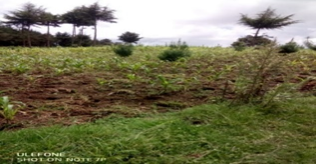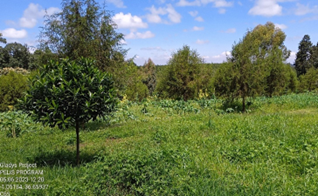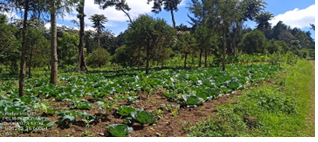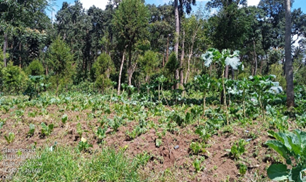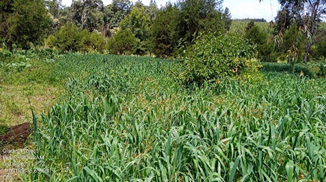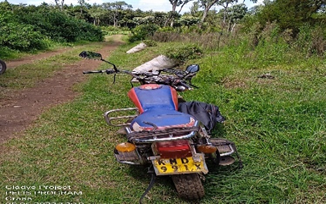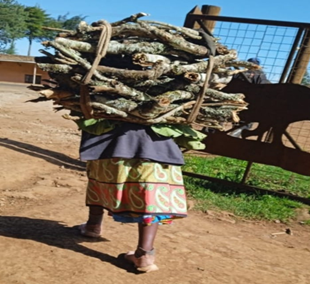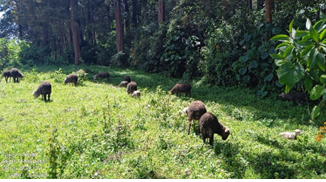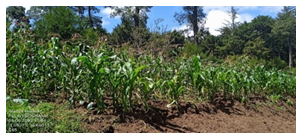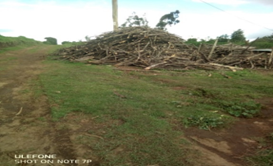Use of Plantation Establishment and Livelihood Improvement Scheme (Pelis) In the Rehabilitation of Nyamweru Forest Reserve, Kiambu County, Kenya.
- James Karanja Kamau
- Salome Wairimu Gikonyo
- Felix L. M. Ming’ate
- 926-937
- Jan 5, 2024
- Environment
Use of Plantation Establishment and Livelihood Improvement Scheme (Pelis) in the Rehabilitation of Nyamweru Forest Reserve, Kiambu County, Kenya.
James Karanja Kamau*, Salome Wairimu Gikonyo, Felix L. M. Ming’ate
Department of Environmental Studies and Community Development, Kenyatta University, Nairobi, Kenya.
*Corresponding Author
DOI: https://dx.doi.org/10.47772/IJRISS.2023.7012071
Received: 29 November 2023; Revised: 06 December 2023; Accepted: 09 December 2023; Published: 04 January 2024
ABSTRACT
PELIS is a program globally known as the Taungya system, which involves the allocation of parcels of land to forest-adjacent communities to grow tree seedlings as well as carry out cultivation of crops during the early stages of tree seedlings growth until they form canopies, with the aim of increasing forest cover. The program has been successful in some countries, but it has failed in other countries, especially developing countries. This study investigated the impeding factors to the realization of the PELIS program, using a case study of the Nyamweru forest reserve in Kiambu County, Lari sub-county, Kenya. Descriptive research design was employed, with a sample size of 40 respondents. About 80% of the results showed an apparent weakness of the institutions mandated in the governance of the forest to effectively manage PELIS program. The study concluded that all the challenges experienced under the PELIS program can be linked to poor forest governance practices. The study recommended, that an integrated watershed resource management, adoption of a bottom-up approach in order to achieve participatory forest management in all aspects of the PELIS program, and development of a platform for awareness creation, such training and use of current technologies, to strengthen and enhance social capital in PELIS program Management in order to, rejuvenate and achieve the constitutional recommended 10% of forest cover in Kenya.
Keywords: Plantation Establishment Livelihood Improvement Scheme (PELIS, Taungya system, Forest Adjacent Community (FAC), Non-Residential Cultivation (NRC) and Kenya Forest Service (KFS).
INTRODUCTION
Plantation Establishment and Livelihood Improvement Scheme (PELIS)/Taungya Scheme is a program for forest management that was introduced by the Kenya Forest Service (KFS) after the passing of the legislation Forest Act 2005 (GOK, 2015), mainly for the rehabilitation of degraded areas, increase forest cover, improve the social and economic status of the communities residing adjacent to forested areas while sensitizing them over the importance of the forest (Liese, 2010; Cherop, 2023).
The program involves allocating a portion of the land to the Forest Adjacent Communities (FAC) by the relevant forest department, mandating them to carry out farming activities in the early stages of tree seedlings as well as take care of the tree seedlings until they form canopies (de Jong, 2010; Pintér, 2018). Formation of canopy ousts the farmer out of the parcel allocated within an approximate period of 2-3 years. It’s the cheapest means of increasing plantation, livelihood improvement, and poverty eradication (Yeboah, 2016).
Globally, the system was first practiced in Burma in 1850s in the southern part of Asia, introduced by the British during the 19th century. The system has been widely used across the globe as a way of enhancing sustainable forest management through the incorporation of the needs of present generations without compromising the ability of the future generation to meet their own needs (Amoah, 2009; Iwaki, 2015).
The system has also been adopted in the US and Europe, but it has been much more dominantly incorporated in southern Asia and Africa (Yeboah, 2016). Other countries where it has been practiced include Thailand, Indonesia, Bangladesh, India, the southern part of China, and the northern part of Bengal (Acheampong, 2011; Okyere-Amoateng, 2022).
It was introduced in Africa in 1887 in South Africa, and later on, it was adopted in Nigeria, Tanzania, Gabon, Sierra Leone, Uganda, Ethiopia, Togo, and now in Kenya as PELIS. In Kenya, the scheme has been adopted in various parts of the country, including the following: Baringo, Kericho, Nakuru, Kajiado, Elegeyo Marakwet, Nandi Tran-Nzoia, Uasin Gishu, Migori, Bungoma, Kakamega, Meru and Kiambu (Kagombe, 2005; Alabi, 2023).
The program has been partially successful in most countries, for example, in Burma, Southern China, and Thailand, despite the incorporation of mechanisms such as: adoption of the bottom-up approach, development of environmental education programs, use of the participatory approach in the decision and policy-making process, incorporation of indigenous knowledge system and adoption of current technologies, for example, remote sensing and GIS technologies (Appiah, 2015). But it has failed in some regions in Asia and Africa due to challenges such as sabotage of tree seedlings by the farmers basically to extend their period of stay, lack of motivation and introduction of other crops not compatible with the tree seedling grown (Boafo, 2013; Kikoti. 2015). For example, in Uganda, the agreed crop to be grown was leguminous, but the farmers ended up extending other variety of crops, for example, maize, sugarcane, and sorghum, which choked the seedlings (Adegeye, 2011).
Also the failure of farmers to weed around the tree seedling leads to stunted growth of trees, Further inadequate and misappropriation of funds meant to run the PELIS program, inadequate participation by the PELIS members in decision making, absence of a clear mechanism for sharing benefits accruing from the forest, inadequate support from the implementing agencies on the appropriate farming mechanism used by the farmers and difficulty in maintaining the communities’ enthusiasm, commitment and efforts over a long term, high poverty levels have accelerated the rate of degradation through illegal logging for construction, firewood, and charcoal burning (Amoah, 2009; Mbuvi, 2009, Ming’ate, and Lonzi. 2022).
Based on the above challenges, this paper sought to answer three questions by using Nyamweru Forest as a case study: (1) What is the history of PELIS in the Nyamweru forest reserve? (2) How were the communities involved in the establishment of the PELIS system in Nyamweru forest? (3) What are the challenges impeding PELIS sustainability in Nyamweru forest?
METHODOLOGY
The study was carried out within Nyamweru forest reserve, Kirenga ward, Lari constituency, Kiambu county, Kenya.
Figure 1: A map illustrating the Nyamweru forest.
According GoK, (2019), Kirenga ward has a population of approximately 42,358, with the main economic activity being agriculture, which is carried out under a mixed form of farming. The type of soil is loam, which permits free percolation of water and is slightly acidic, thus favoring the growth of tea. On the upper part of the forest, there is a tea zone that was introduced as a buffer during the Nyayo tea zone’s era. The estimated terrain elevation above sea level is 2315 meters. The area is gently sloping, with least parts having steep slopes. The topography is backed by a few valleys and ridges, which have streams from springs. The area receives an average annual rainfall of slightly above 1500mm, which is reliable and enough. The long rains fall between April and July, and short rains between November and December. The average annual temperature is 21 degrees Celsius. To achieve the objectives of the study, the target population consisted of households members involved in PELIS scheme within Nyamweru forest, the government authorities in charge of Nyamweru forest and NGOs, The criteria for selecting the key informants were based on their knowledge and experience with the PELIS scheme in the Nyamweru forest.
The study utilized descriptive research design since it was concerned with describing systematically and accurately the facts and characteristics of the farmers involved in the PELIS program in Nyamweru. Also, it intended to give a proper account of the situation of the farmers involved in PELIS (Thomas, 2013; Dubey, 2022, Ming’ate 2014). To achieve the study objectives, the sample size was calculated using the following formula (Kothari, 2004; Chaokromthonga, 2021).
SS= z2.p.q.n
e2 (n-1) +z2.p.q
SS = Desired minimal sample size in Nyamweru forest
z = Standard normal deviation equivalent to 1.96 confidence level
p = Proportions of respondents possessing the desired characteristics (0.05)
q = (1-p)
e = Precision (0.05)
According to the GoK, (2019), the approximate population of the Nyamweru forest adjacent communities is about 1,109, with 89 registered members.
SS = (1.96)2 (0.05) (1-0.05) (89)
(0.05)2 (89-1) + (1.96)2 (0.05) (1-0.05)
SS = 40.3540 ≈ 40
Thus, the sample size is equivalent to 40 respondents (Table 1).
Table 1 showing the distribution of sample size
| Type of Respondent | Number |
| PELIS members | 20 |
| Forest Adjacent community | 10 |
| Kenya Forest Service (KFS) | 5 |
| Non-Governmental Organization (Kijabe Environment Volunteer) | 5 |
| Total | 40 |
Both closed and open-ended questionnaires were used for data collection. Photographs depicted various stakeholder’s activities and features. Photographs were also used to depict day to day activities of people living around Nyamweru forest. The Heads of the department from Kenya Forest Service and Non-Governmental Organizations (Kijabe Environment Volunteer) were used as key informants for the study. Data was also collected from documents, namely: journals, newspapers, magazines and periodicals. The quantitative data collected through questionnaires was analyzed through the use of Statistical Package for Social Sciences (SPSS), while the qualitative data collected was analyzed by grouping the data into similar themes and using it to augment quantitative data.
RESULTS
The study set to answer three questions in the current literature using Nyamweru as a case study (1). What is the history of PELIS in the Nyamweru forest reserve? (2). How were the communities involved in the establishment of the PELIS system in Nyamweru forest? (3). What are the challenges impeding PELIS sustainability in Nyamweru forest? The results are presented below.
3.1 History of PELIS in Nyamweru Forest Reserve
Nationally, the Taungya system was introduced in Kenya in 1910 as a “Shamba System, “which is a modified form of the Taungya system (Witcomb, 2009). The approach led to the increase of forest plantation and the improvement of the local livelihood until 1990 when changes in socio-economic factors marred the system; farmers increased interest in agricultural activities with respect to tree seedlings. It’s clearly articulated that farmers did not weed out around the tree seedling, which ensured that the tree seedlings were choked, or else they intentionally sabotaged the tree seedling, thus increasing the time of stay in the field of land allocated (Witcomb, 2009; Kijazi, 2011). The above measures impeded the progress of forest plantation and thus reduced the economic revenue collected resulting from timber. This prompted a presidential ban over the “Shamba System,” and all the peasants were evicted from the forested areas. The system was swapped with the Non-Residential Cultivation (NRC), where farmers are integrated into the forest department as employees. The farmers were to work on the piece of land allocated for nine months only. The system ceased its operation due to many restrictions, for example, ruling farmers what to do (Witcomb, 2009).
Nyamweru forest reserve is located in Kiambu county, Lari sub-county, Nyamweru village. The forest was gazette in the early 1980s, and the “Shamba system” was introduced in the late 1990s (Koech, 2009). PELIS system was introduced with the aim of increasing forest cover generally in the country after the enactment of the Forest Act 2005, where the communities residing adjacent to the forest were given the mandate over the control of the forest and management, this was due to the fact that the indigenous knowledge envisaged by the ingrained communities could also be utilized to salvage cases of forest degradation emanating from population and economic increase in demand for timber and agricultural development (Kagombe, 2018).
The communities surrounding the forest include the Githongoiyo Community Forest, Kambaa Community Forest, Githirioni Community Forest and Matimbei Community Forest. The above were the selected communities that have been working under the PELIS system surrounding Nyamweru Forest Reserve. The “Shamba System” ran smoothly until 2013 when, after scrutiny and analysis of the area, it was realised that the program and plans laid down were not achieved.
The PELIS program has not been functioning as intended, and it has not gotten its roots as was anticipated, as well as achieve its activities due to a couple of mishaps (Ikiara, 2010). The land to be cultivated is divided into slots, which are further given to the communities. The communities are supposed to cultivate the land for one year to make it fertile, after which tree seedlings are introduced (Mbuvi, 2009). The farmer is given a mandate to control the land and take care of the tree seedlings until they form a canopy, after which the farmer leaves the farm, and the area is closed to ensure the growth of the trees undisturbed (Kagombe, 2018: Musyoki, 2022).
3.2: How were the communities involved in the establishment of PELIS system in Nyamweru forest.
The study was interested in understanding if education had a relationship with decision and policy making in the involvement of a member in the PELIS program. It became apparent from those without education that the education level is not a determinant factor for involvement in PELIS program decision-making and policy formulation as indicated in table 2 by about 37.5% of the household respondents agreeing with 50% disagreeing. Those who had attained primary education also confirmed the finding that education 68.7% is not a determining factor in getting involved in PELIS. This was different with the respondents who had attained secondary education, in whom the majority, about 55%, indicated that education is important for involvement in PELIS. This could be attributed to the fact that mainly those who have attained secondary education do not get involved in PELIS as they always want to join colleges.
The (Table 2) below also indicates these findings. In contrast, however, those who had attained college education and above 57.1 % reported that education is not a determinant of involvement in PELIS.
Table 2: Use of education levels in decision-making and policy
| Decision making and policy | ||||
| Agree | Undecided | Disagree | ||
| Education level | uneducated | 37.5% | 12.5% | 50% |
| Primary | 12.4% | 18.8% | 68.7% | |
| Secondary | 55.5% | 11.1% | 33.3% | |
| College and above | 42.9% | 57.1% | ||
The other question that was posed to the household respondents was on the age of sharing of benefits accruing from the forest with the PELIS members. The results showed that in all age brackets, the majority of the househods disagreed that age was not important in benefiting from PELIS (Table 3). However, a thorough interrogation indicated that only those who were aged above 18 years are allowed to access the PELIS program. Sharing of the benefits enhances the morale of the members and strengthens the rapport between them and the forest management. It also creates a sense of belonging and identity for community members.
Table 3: Age to sharing of benefits
| Sharing of benefits | ||||
| Agree | Undecided | Disagree | ||
| Age | Below 25 years | 16.6% | 16.7% | 66.6% |
| 26-35 years | – | – | – | |
| 36-45 years | 27.3% | 9.1% | 63.6% | |
| Above 45 years | 25% | 18.8% | 56.2% | |
In terms of the allocation of land for cultivation to PELIS members about 97.5% agreed while 2.5% were undecided on land allocation for cultivation as one of the processes of involving members in the PELIS scheme (Yeboah, 2016).
The study explored if capacity building of members on PELIS program by forest extension officers was a determinant for involvement in the program. This involves extensional training offered to community members to enhance their ability to implement the PELIS program. From the (Table 4) below, it can be inferred that about 72% disagreed that capacity building is not a determining factor for involvement in PELIS, with only 15% agreed that it is a factor. This can be linked to the high level of corruption that has marred the program. According to CFA rules, as explained by one of the respondents:
Capacities building of the PELIS program enhances the community members skills, techniques, and knowledge, thus enhancing their ability to run the program sufficiently.
Table 4: Capacity building by the forest extension Officers
| Agree | Undecided | Disagree |
| 15% | 12.5% | 72.5% |
The households were asked to explain if they knew how to handle the PELIS program such that it would increase the forest cover and restore degraded areas. The household enumerated the activities that they are supposed to do in order to achieve this objective as follows as stipulated in their forest management plan. That members are supposed to: (i) stop agricultural activities once the canopy forms (ii) take care of the tree seedlings up to the period stipulated (iii) use agrochemicals to improve the farm’s fertility (iv) replace the tree seedlings in case some withers out.
3.3 The PELIS Activities carried out by Farmers in Nyamweru Forest
Unfortunately, despite the awareness of the rules as stipulated in their Forest Management plan, the study revealed that some of the areas still needed tree planting. As indicated in plates 1, 2, 3, 4, and 5 below. It can be inferred from the discussion above that the capacity of PELIS members is not well enhanced, and the core reason is the failure of forest extension officers to capacity-build PELIS members as well as the reduced cohesion between the forest department and the PELIS members.
The researchers also took photographs of the various activities that are part of the CFA program. The study found that CFA members are involved in various activities including tree planting, vegetable growing, e.g., cabbages, spinach, kales, maize, cutting grass to feed their livestock and fuel wood collection as shown in the plates below. However, as indicated by the photographs, the trees need to be better-taken care of, to avoid huge gaps as shown in the plates below. This could be attributed to the fact that some of the PELIS members wish to extend their period of stay in the forest for many years to continue farming. Further, by the time of the study, some farmers had not weeded around the trees.
Plate 1: Shows spaced trees due to bad management of the PELIS Programme by the Nyamweru CFA members.
Plate 2: Also shows spaced trees due to bad management of the PELIS Programme by the Nyamweru CFA members.
Plate 3: Indicates cabbages planted together with Cyprus trees (Cupressus lusitanica) in a PELIS Programme with spaced tree.
Plate 4: Shows kales, spinach and cyprus tress (Cupressus lusitanica)
Plate 5: Shows an Exotic rye Grass grown by one of the CFA members involved in the PELIS programme.
Plate 6: Indicates a local community member with a motorbike cutting grass to feed his for livestock from the forest.
Plate 7: Indicates a CFA member Carrying Fuel wood collected from the forest
Plate 8: Shows a CFA member grazing sheep in the forest
3.4: Challenges impeding PELIS sustainability in Nyamweru forest
The challenges enumerated by households impeding the Sustainable Management of PELIS program in Nyamweru Forest include:
Corruption, where some PELIS members reported that corruption is a major challenge in the implementation of PELIS. The quote below from one of households sums this finding:
Let me give an account whereby KCB bank, through its corporate social responsibility, funded the tree planting expedition to ensure that the 10% constitutional forest cover is reached. Instead, the forest department used the benefits of the PELIS scheme, which ended up in the long run with half of bread and soda for an enormous activity, and this seems to be a core factor that derailed members’ morale towards the PELIS scheme.
Further high rate of corruption can be affirmed from Plate 10, where trees are cut from the forest and sold to locals as charcoal or firewood. The heap is an example of stolen tree branches that are supposed to benefit PELIS members as per their management plan after harvesting trees. Those in authority instead take the branches and sell them to benefit themselves. Also, corruption was manifest through the embezzlement of organizational funds, paying ghost workers, and misuse of public office for personal gain. All of these undermine the productivity of the PELIS program. Lack of rapport between the forest department and communities also provided the grounds for ineffectiveness curtailing the whole system.
Plate 9: Indicates maize grown by one of the CFA members
Plate 10: Shows a pile of firewood at a forest officer’s place of resident
Also, inadequate competency to implement the PELIS program, lack of adequate skills, knowledge and inadequate technology, illegal logging, sabotage of tree seedling, mainly aiming at extending the period of stay in the farm allocated, failure of application of terms and conditions in PELIS program by the forest department, also failure of the forest authority to include all members involved in PELIS in the decision-making process, sharing of benefits accruing from the forest which enhances their morale and high usage of agrochemicals that change the PH of the soil, thus limiting the species that can grow are all challenges facing PELIS Program in Nyamweru Forest.
CONCLUSIONS
The study set out to examine the following questions: (1) What is the history of PELIS in the Nyamweru forest reserve? (2) How were the communities involved in the establishment of the PELIS system in Nyamweru forest (3) What are the challenges impeding PELIS sustainability in Nyamweru forest? It can be concluded that the PELIS program has existed since the 1990s even though it was fully enacted in Nyamweru in 2005 with the coming of the Forest Act 2005. In the PELIS program, farmers are given control of the land until trees form the Canopy, and then trees are left to grow on their own. Households are also aware of how they are supposed to handle the PELIS process, even though they are faced with several challenges. The PELIS program still faces challenges and can only succeed if the CFA members and Kenya Forest Service take the regulations supporting it seriously (Musyoki, 2022).
RECOMMENDATIONS
It can be recommended that;
- There is a need to use participatory approaches in the decision-making and policy-making process. Communities were moderately involved more in functional participation and rarely in the decision and policy-making process.
- There should be dissemination of information by the local authority to the local members regarding plans and developments. This makes the communities to be enlightened, feel part of the system, and avoid confusion and conflict of ideas.
- Enhancement of partnership with various organization, thus linking them with social networks from the outside which will assists them through financial, technical and ideology in the management of the forest.
- Reforms on forest governing structures should aim to do away with corruption and thus operationalization of PELIS program.
- Development of environmental education programs to promote the sustainable use and understanding of biodiversity and the environment at large is necessary.
- There is a need to strengthen gaps in policies that govern the conservation and management of forest reserves in Kenya.
REFERENCES
- Acheampong, E. and E. Marfo. 2011. The impact of tree tenure and access on chainsaw milling in Ghana. Ghana Journal of Forestry 27: 68-86.
- Adegeye, A. O., Jimoh, S. O., & Agera, S. I. (2011). Agricultural productivity under taungya and non-taungya land-use options: a case study of Vandeikya Local Government area, Benue State, Nigeria. International Journal of Biological and Chemical Sciences, 5(6), 2343-2350.
- Alabi, O. O., Bayei, J. D., Aluwong, S. J., Makarau, S. B., Ojokojo, P. P., Olumuyiwa, S. A., & Ibeh, H. C (2023). Farm level adoption of agroforestry production technology among smallholder farmers in Kaduna state, Nigeria. Australian Journal of Science and Technology ISSN Number (2208-6404) Volume 7; Issue 2.
- Amoah, A. (2009). Analysis of modified taungya system from socio-economic and biodiversity perspective: A case study in Sunyani Forest District, Brong-Ahafo Region of Ghana (Doctoral dissertation) Kwame Nkrumah University of Science and Technology, Kumasi, Ghana.
- Appiah, M, Fagg M.& Pappinen A. (2015) A Review of Reforestation Approaches in Ghana: Sustainability and Genuine Local Participation Lessons for Implementing REDD+ Activities. European Journal of Scientific Research ISSN 1450-216X / 1450-202X Vol. 131 No 1 April, 2015, pp.70-99.
- Badu Yeboah (2016). Sustainability Assessment of the Modified Taungya System in Dormaa District of Ghana: 15- Years after Implementation. University of Eastern Finland, Faculty of Science and Forestry and CSIR-FORIG/UEF Graduate School, Master’s thesis in Bio-Economy and Natural Resources Management (ECORES), 55 p.
- Boafo, J. (2013). The impact of deforestation on forest livelihoods in Ghana. Africa portal. A project initiative. The Africa Portal Backgrounder.
- Chaokromthong, K., & Sintao, N. (2021). Sample size estimation using Yamane and Cochran and Krejcie and Morgan and green formulas and Cohen statistical power analysis by G* Power and comparisions. Apheit International Journal, 10(2), 76-86.
- Cherop, C. K., Okuro, S., & Odhiambo, G (2023). Shamba System of Forest Management and The Elgeyo Marakwet Agro-Pastoral Economy During the Post-Colonial Period, 1963. International Journal of Innovative Research and Advanced Studies (IJIRAS) Volume 10 Issue 7.
- de Jong, W. (2010). Forest rehabilitation and its implication for forest transition theory. Biotropica, 42(1), 3-9.
- Dubey, U. K. B., & Kothari, D. P. (2022). Research methodology: Techniques and trends. CRC Press.
- GOK (2015). Environmental Management and Coordination Act (EMCA), Government Printer, Nairobi, Kenya.
- GOK (2019). Kenya Population and Housing Census Volume II: Distribution of population by Administrative Units. Kenya Bureau of Statistics, Government Printer, Nairobi, Kenya.
- Ikiara, I. G. (2010). Challenges facing forest plantation establishment through shamba system: the case of Mucheene forest (Doctoral dissertation, University of Nairobi, Kenya).
- Iwaki, T. (2015). The Village System and Burmese Society: Problems Involved in the Enforcement Process of the Upper Burma Village Regulation of 1887. Journal of Burma Studies, 19(1), pp.113-143.
- Kagombe, J. K., & Gitonga, J. M. (2005). Plantation establishment in Kenya. The Shamba system case study. Kenya Forests Working Group, Nairobi, Kenya.
- Kagombe, J. K., Cheboiwo, J. K., Gichu, A., Handa, C., & Wamboi, J. (2018). Payment for environmental services: status and opportunities in Kenya. Journal of Resources Development and Management Journal, 40. 1-13
- Kijazi, M. H., & Kant, S. (2011). Evaluation of welfare functions of environmental amenities: A case of forest biomass fuels in Mount Kilimanjaro, Tanzania. Ecological Economics, 72, 129-139.
- Kikoti, I. A., Mligo, C., & Kilemo, D. B. (2015). The impact of grazing on plant natural regeneration in northern slopes of Mount Kilimanjaro, Tanzania. Open Journal of Ecology, 5(06), 266.
- Koech, C. K., Ongugo, P. O., Mbuvi, M. T. E., & Maua, J. O. (2009). Community Forest Associations in Kenya: challenges and opportunities. Kenya Forestry Research Institute, Nairobi, Kenya.
- Kothari C.R., (2004). Research Methodology: Methods and Techniques. New Age International publishers limited. New Delhi.
- Liese, A. (2010). Explaining varying degrees of openness in the food and agriculture organization of the United Nations (FAO). In Transnational actors in global governance: Patterns, explanations and implications (pp. 88-109). London: Palgrave Macmillan UK.
- Mbuvi, M. T., Maua, J. O., Ongugo, P. O., Koech, C. K., Othim, R. A., & Musyoki, J. K. (2009). Perceptions on participatory forest management impacts on poverty for selected forest adjacent communities in Kenya. Nairobi: The Action Research into Poverty Impact of Participatory Forest Management (ARPIP) & Nairobi: the Kenya Forestry research Institute (KEFRI).
- Ming’ate M.L.F & Lonzi Z. (2022). Formation of participatory Forest Management Boundaries for governance of Arabuko-Sokoke Forest Reserve in Kenya. Asian Journal of Environment & Ecology. 17(1):1-9
- Ming’ate M.L.F., (2014). Combining ethnography and case study research designs in studying forest co-management approaches. Journal of Human and Social Science Research. Vol. 3 No. 2, 67-79.
- Musyoki, J. K., Ming’ate, F. L. M., & Muriithi, J. K. (2022). Factors Determining Household Membership to Community Forest Association for Participation in Management of Upper Imenti Forest, Meru County, Kenya. Open Access Library Journal, 9(10), 1-18.
- Okyere-Amoateng, R., & Abugre, S. (2022). Enhancing the Viability of the Modified Taungya System through Bee Keeping. Journal of Sustainable Forestry, 41(8), 706-720.
- Pintér, L., Hardi, P., Martinuzzi, A., & Hall, J. (2018). Bellagio STAMP: Principles for sustainability assessment and measurement. In Routledge handbook of sustainability indicators (pp. 21-41). Routledge.
- Thomas, C. M. (2013). Participatory forest management and actor role dependency in Arabuko-Sokoke Forest Reserve, Kenya (Doctoral dissertation, University of Oregon).
- Witcomb, M., & Dorward, P. (2009). An assessment of the benefits and limitations of the shamba agroforestry system in Kenya and of management and policy requirements for its successful and sustainable reintroduction. Agroforestry systems, 75, 261-274.


